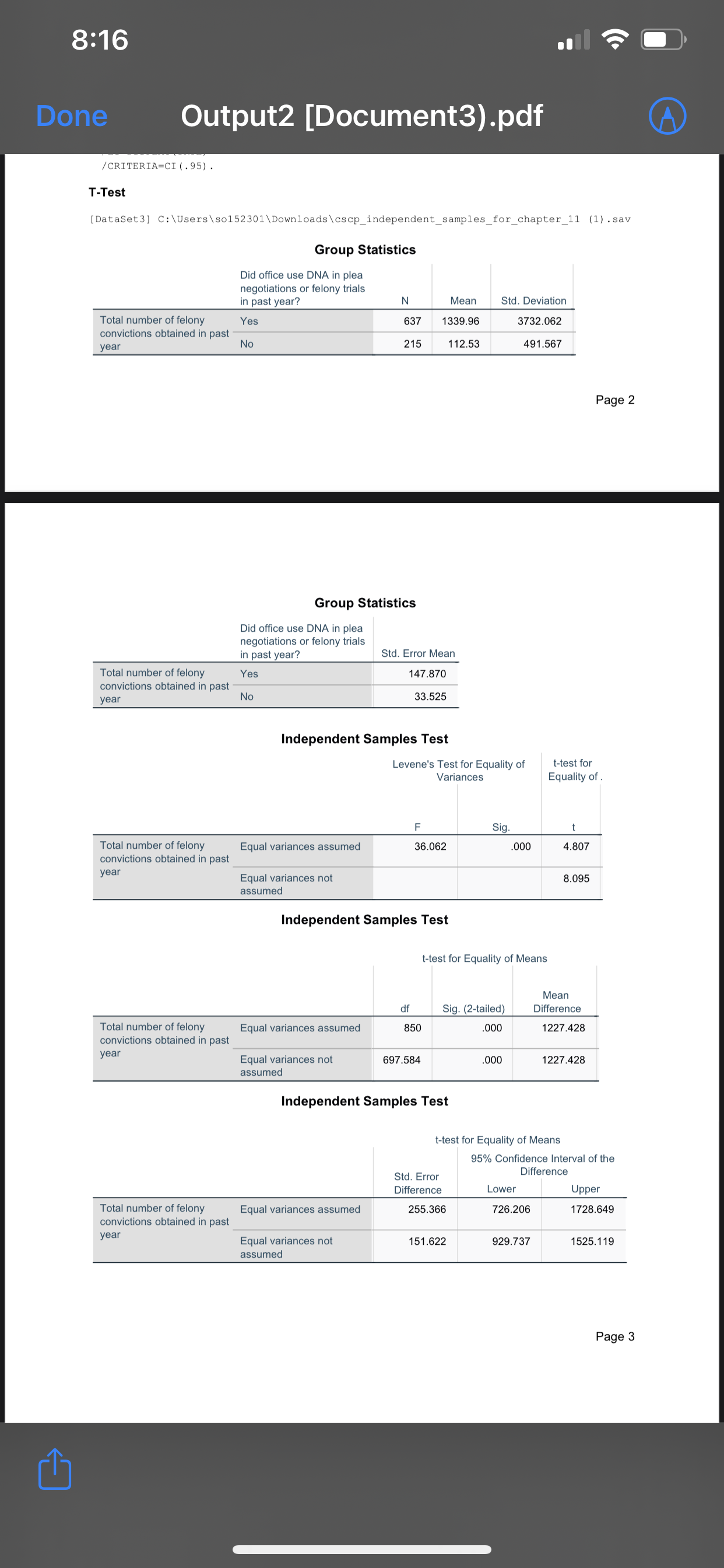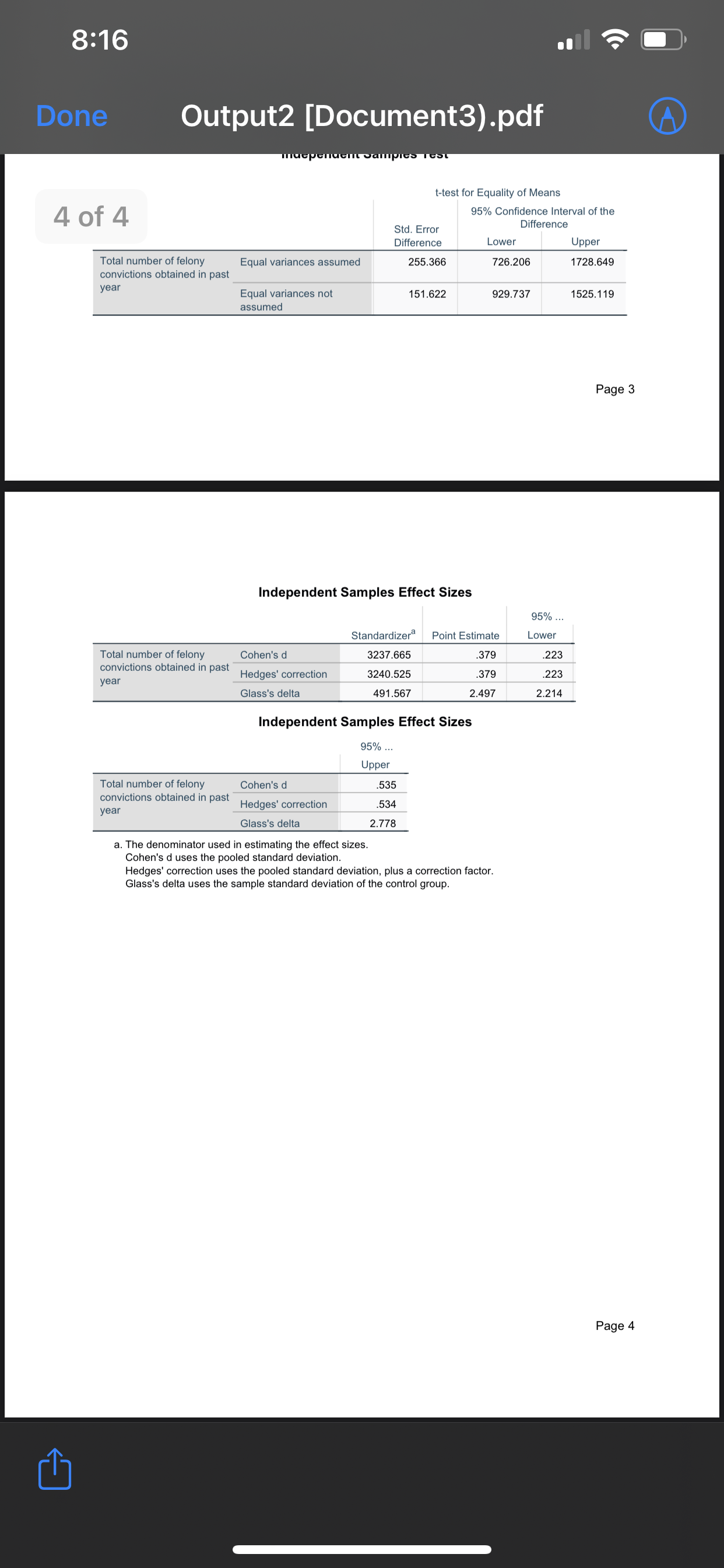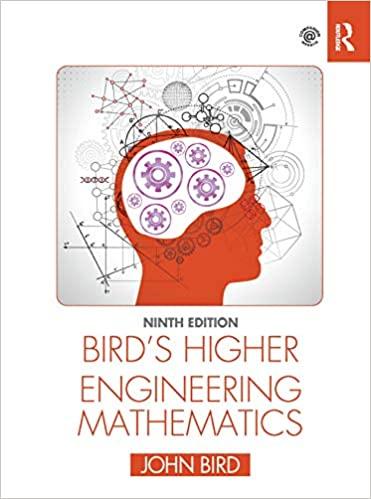8:16 Done Output2 [Document3).pdf / CRITERIA=CI ( . 95) . T-Test [DataSet3] C: \\Users\\so152301\\Downloads\\csep_independent_samples_for_chapter_11 (1) . sav Group Statistics Did office use DNA in plea negotiations or felony trials in past year? N Mear Std. Deviation Total number of felony Yes 637 1339.96 3732.062 convictions obtained in past year No 215 112.53 491.567 Page 2 Group Statistics Did office use DNA in plea negotiations or felony trials in past year? Std. Error Mean Total number of felony Yes 147.870 convictions obtained in past year No 33.525 Independent Samples Test Levene's Test for Equality of t-test for Variances Equality of . Sig. Total number of felony Equal variances assumed 36.062 000 4.807 convictions obtained in past year Equal variances not 8.095 assumed Independent Samples Test t-test for Equality of Means Mean df Sig. (2-tailed) Difference Total number of felony Equal variances assumed 850 000 1227.428 convictions obtained in past year Equal variances not 697.584 000 1227.428 assumed Independent Samples Test t-test for Equality of Means 95% Confidence Interval of the Std. Error Difference Difference Lower Upper Total number of felony Equal variances assumed 255.366 726.206 1728.649 convictions obtained in past year Equal variances not 151.622 929.737 1525.119 assumed Page 3t-test for Equality of Means 4 f 4 95% Condence Interval cfthe 0 Difference Std. Error Difference Lower Upper Tolal number of felony Equal variances assumed 255.366 726.206 1728.649 convictions obtained in past year Equal variances not 151.622 929.737 1525.119 assumed Independent Samples Effect Sizes Standardizera Point Estimate Total number of felony Cohen's d 3237.665 .1379 Sigma\" obtain\" in pa\" Hedges' correction 3240.525 .379 Glass's delta 491.567 2.497 Independent Samples Effect Sizes 95% Upper Total number of felony Cohen's d .535 convictions obtained in past year Hedges' correction .534 Glass's delta 2.778 a. The denominator used in estimating the effect sizes. Cohen's d uses the pooled standard deviation. Hedges' correction uses the pooled standard deviation, plus a correction factor. Glass's delta uses the sample standard deviation of the control group. 23. Do pedestrian stops vary in duration depending on the time of day at which they take place? The data set from the Police- Public Contact Survey (PPCS) PPCS Independent Samples for Chapter 11.sav (www.sagepub.com/gau) contains the variables time and minutes , which measure whether a stop took place during the day or at night and the number of minutes the stop lasted. Run an independent-samples / test to determine whether these two variables are related. 1. At an alpha level of .05, will you use the results for the pooled/equal variances / or that for separate/unequal variances? How did you make this decision? 2. What is the obtained value of / ? 3. Would you reject the null at an alpha level of .01? Why or why not? 4. What is your substantive conclusion? In other words, are there significant differences between the two IV groups? Are the IV and the DV related? 24. Do juveniles facing charges for violent crimes have more total charges filed against them compared to juveniles charged with property crimes? The JDCC data set contains information on charge type and total charges. The data file JDCC Independent Samples for Chapter 11.sav (www.sagepub.com/gau) contains the variables offense and charges. Run an independent-samples test to determine whether offense type appears to be related to the total number of charges. 1. At an alpha level of .05, will you use the results for the pooled/equal variances f or that for separate/unequal variances? How did you make this decision? 2. What is the obtained value of ? 3. Would you reject the null at an alpha level of .05? Why or why not? 4. What is your substantive conclusion? In other words, are there significant differences between the two IV groups? Are the IV and the DV related? 25. Critics of the use of DNA evidence in criminal trials sometimes argue that DNA usage would clog up courts due to the delay caused by waiting for labs to return test results. Supporters claim, though, that any such delays would be justified by the improvement in the accuracy of felony convictions and acquittals. The Census of State Court Prosecutors is contained in the file CSCP Independent Samples for Chapter 11.sav. The variable DNA measures whether a prosecutor's office uses DNA evidence in plea negotiations or in criminal trials, and the variable convictions displays the number of felony convictions the office obtained within the past year. Run an independent-samples / test. 1. At an alpha level of .05, will you use the results for the pooled/equal variances / or that for separate/unequal variances? How did you make this decision? 2. What is the obtained value of t ? 3. Would you reject the null at an alpha level of .01? Why or why not? 4. What is your substantive conclusion? In other words, are there significant differences between the two IV groups? Are the IV and DV related? 26. In Question 23, we did not account for PPCS respondents' demographic characteristics. We can ask the same question- whether stop duration varies across day and night-and this time narrow the sample down by gender and race to create a subsample of white males. This strategy removes any potentially confounding effects of gender and race, and allows us to isolate the effects of the dayight variable. Using the data set PPCS Matched Pairs for Chapter 11.sav (www.sagcpub.com/gay), run a dependent samples / test using the day and night variables. 1. What is the obtained value of t? 2. Would you reject the null at an alpha level of .05? Why or why not? 3. What is your substantive conclusion? In other words, are there significant differences between the two IV groups? Are the IV and the DV related









